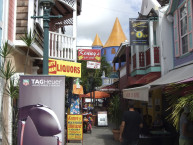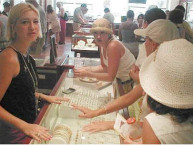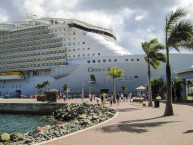St Thomas, US Virgin Islands
Columbus discovered the Virgin Islands during his second voyage to the new world in 1493. The flags of Spain, France, England, Holland, Dennmark and the United States have flown over the islands.
In 1674 four houses/taverns were built along the waterfront to the west of Fort Christian. Until then Fort Christian was the only structure built on the coastline of the agricultural colony. These taverns were so popular with the early settlers and seamen who visted, it became known as Taphus, or Beer Hall. In 1691 the town was renamed to Charlotte Amalie in honor of the wife of King Christian V.
Priracy and slave trade was flourishing and provided the economy enough money to develop and grow. By 1700 piracy gave way to legitimate trade, where once were bucaneers, now stood properous legitimate merchants. In 1764 St Thomas was declared a free port, and by 1800 it was the trading center of the West Indies.
The next two decades saw some of the islands’ worst fortune. Fires repeatadly burned down the town of Charlotte Amalie. Trade embargos, rising competition from beet/sugar trade and the abolition of slave trade in the early 1800’s all impacted the Virgin Islands’ economy.
By 1900 St Thomas’ economy no longer enjoyed properous times like it had a century before. During World War I the United States purchased the Virgin Islands for $25 million in gold. After World War II the islands’ free port status and increased tourism brought prosperity back to the island.
Charlotte Amalie boasts much of the finest duty-free shopping, especially on Waterfront and Main Streets. Restored seventeenth-century and eighteenth-century warehouses along the waterfront, which once held molasses, rum, spices, and other trade goods, now house a variety of unique shops.
US citizens are allowed a duty-free shopping quota of $1,200 – twice that of any other island in the Caribbean and three times that of European countries. A flat rate of five percent duty is charged on purchases over your $1,200 allowance, up to a maximum of $1,000 more. Besides your personal exemption, you can mail friends and relatives at home an unlimited number of gifts (other than perfume, liquor, or tobacco) worth $100 or less each.
St Thomas currently enjoys one of the most robust Jewelry markets in the world.
Jewelry and gemstones from all over the planet are bought and sold here on a daily basis.
Within the Caribbean basin over 6 billion dollars worth of jewelry are sold every year, the majority of the larger more impressive items are sold in St Thomas.
St. Thomas has a number of historic buildings and sights that will take you back in time. You’ll marvel at the Danish architecture found in Charlotte Amalie: well-preserved old warehouses, public buildings, military structures and churches. The island also has its share of modern-day attractions, including a sleek tramway that offers riders breathtaking views of the harbor and town. In the countryside, you can stop at various lookout points and gaze out upon tropical isles and sapphire seas.
A Tour of Charlotte Amalie
No visit to St. Thomas would be complete without exploring Charlotte Amalie. Fascinating architecture, beautiful houses of worship and intriguing museums are just some of the things to discover while walking through its narrow streets. Many of the buildings used as shops today where once the warehouses of pirates!
 99 Steps: Rising steeply from the east side of Hotel 1829 are the famous steps leading to Government House. The bricks used to construct the steps were originally brought from Denmark as ballast in the holds of sailing ships.
99 Steps: Rising steeply from the east side of Hotel 1829 are the famous steps leading to Government House. The bricks used to construct the steps were originally brought from Denmark as ballast in the holds of sailing ships.
Government House: It houses the offices of the governor of the U.S. Virgin Islands. This neoclassical white brick-and-wood building, with a typical red roof and intricate ironwork, commands a magnificent view of the town and harbor. Government House was erected in 1867 as a meeting place for the Danish Colonial Council; it was renovated in 1994.
 Paradise Point Tramway: this comfortable and state-of-the-art aerial tramway will take you on a 700-foot, scenic ascent to Paradise Point, one of the best lookouts on St. Thomas, where you can enjoy panoramic views of colorful sunsets, cruise ships, harbor sailboats, seaplanes, downtown Charlotte Amalie, and neighboring islands.
Paradise Point Tramway: this comfortable and state-of-the-art aerial tramway will take you on a 700-foot, scenic ascent to Paradise Point, one of the best lookouts on St. Thomas, where you can enjoy panoramic views of colorful sunsets, cruise ships, harbor sailboats, seaplanes, downtown Charlotte Amalie, and neighboring islands.
 St. Thomas Synagogue: This is one of the most historically interesting and best preserved buildings on St. Thomas. The Western Hemisphere’s second-oldest synagogue, this temple was constructed in 1833 by Sephardic Jews. The original structure was built in 1796. Since some of the earliest Danish settlers were Jewish, the temple played an important role in the spiritual life of the colony. A fire destroyed the first synagogue in 1804, and the second was dismantled to make room for a larger third, which also burned. In keeping with the Sephardic tradition, the floor of the current structure is covered with sand, symbolizing the ancient flight of the Jewish people out of Egypt and across the desert.
St. Thomas Synagogue: This is one of the most historically interesting and best preserved buildings on St. Thomas. The Western Hemisphere’s second-oldest synagogue, this temple was constructed in 1833 by Sephardic Jews. The original structure was built in 1796. Since some of the earliest Danish settlers were Jewish, the temple played an important role in the spiritual life of the colony. A fire destroyed the first synagogue in 1804, and the second was dismantled to make room for a larger third, which also burned. In keeping with the Sephardic tradition, the floor of the current structure is covered with sand, symbolizing the ancient flight of the Jewish people out of Egypt and across the desert.
 Blackbeard’s Castle: Originally called Fort Skytsborg, this tower was once the stronghold of the notorious pirate Edward Teach, commonly known as “Blackbeard.” Don’t confuse this structure with Bluebeard’s Castle on the eastern edge of town.
Blackbeard’s Castle: Originally called Fort Skytsborg, this tower was once the stronghold of the notorious pirate Edward Teach, commonly known as “Blackbeard.” Don’t confuse this structure with Bluebeard’s Castle on the eastern edge of town.
Fort Christian: The impressive red fort on the Charlotte Amalie waterfront was built in the 1600’s to defend the harbor and settlement. Today it houses a museum.
 Grand Hotel: Built in 1841, it is an excellent example of 19th-century architecture. It has recently been renovated, including restoration of many original features and expansion of the shopping area. It is no longer a hotel.
Grand Hotel: Built in 1841, it is an excellent example of 19th-century architecture. It has recently been renovated, including restoration of many original features and expansion of the shopping area. It is no longer a hotel.
Market Square: On the west end of downtown Main Street is Market Square, where African slaves were once sold to the highest bidder. The auction blocks have been roofed, and now the square serves as an open-air produce market. Saturday is the busiest day, but just about any day has its share of local color and excitement.
Exploring the Island
 Bluebeard’s Castle: Overlooking Charlotte Amalie, this old outpost of Fort Christian is rumored to have once been a haven for the pirate “Bluebeard.”
Bluebeard’s Castle: Overlooking Charlotte Amalie, this old outpost of Fort Christian is rumored to have once been a haven for the pirate “Bluebeard.”
MountainTop: The signs pointing the way to MountainTop will lead you along Route 33 to the summit of St. Peter Mountain, where you’ll find more sensational panoramas. Fifteen hundred feet above sea level, MountainTop is a popular rest stop and shopping area and claims to be the original home of the banana daiquiri.
Drake’s Seat: Overlooks more than 100 Virgin Islands spread out where the Atlantic meets the Caribbean. According to legend, British privateer Sir Francis Drake watched the ships passing through what is now called Drake’s Passage from this point.
West Indian Company Dock: This is where the cruise ships come in to port and is also the location of Havensight Mall, a large shopping area that can be quite crowded when there are a number of cruise ships in port.



